
There are still big uncertainties about how quantum computing (QC) will evolve — will there be a breakthrough, when might it happen, and which technologies and applications do we expect to succeed?
This Viewpoint shares the results of a Blue Shift by Arthur D. Little (ADL) survey, inviting more than 500 experts and industry executives to gauge their views on critical uncertainties and future scenarios; to draw conclusions on technology maturity, pace, and impact; and to help illustrate what this might mean for business.
UNCERTAINTIES ABOUT THE FUTURE OF QUANTUM COMPUTING
Investment in QC development has been rapidly accelerating, and expectations of its potential to transform business and society have never been higher. More than 20 new prototype QC devices are currently promised by the leading players in their development roadmaps up to 2030. However, despite all the excitement, up to now no devices have yet moved beyond proof-of-concept stage at lab scale, and so-called quantum advantage over conventional computing technologies has yet to be properly demonstrated. There are still big uncertainties about when, and if, quantum computers will become commercially viable, and the full range of applications for which they will be suitable.
In Blue Shift by ADL’s recent comprehensive Report, “Unleashing the business potential of quantum computing,” we explored the current status of technology development in quantum computing, its potential use cases and applications, and what business should be doing now to prepare. To complement this, we conducted a survey approaching some 500 experts in QC technology development based in 20 countries around the world. We asked them to give their opinions on the likelihood of a breakthrough within the next decade, which technology approaches are likely to be most successful, and key uncertainties and their impacts on development and commercialization. We aggregated their views to help identify four possible scenarios for how quantum computing could develop and how businesses should best respond. This Viewpoint summarizes the results of the survey and analysis, including some selected results from a patent analysis by our partner Questel, an end-to-end intellectual property solutions provider to more than 20,000 clients worldwide. For more explanation and background on QC concepts and technologies, please refer to our main Report, “Unleashing the business potential of quantum computing.”
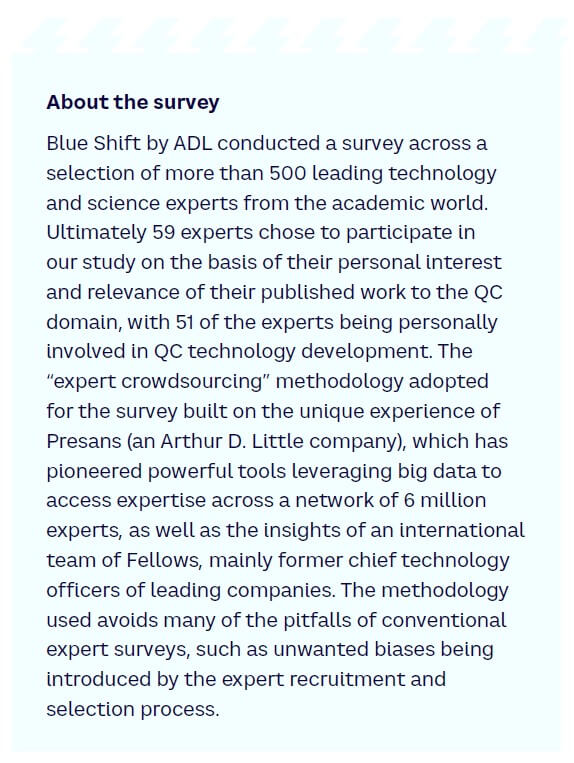
WHAT ARE THE EXPECTATIONS ABOUT THE SUCCESS OF QC TECHNOLOGY?
Around 80% of experts expect quantum advantage over conventional computing to be achieved within a decade.
The overwhelming majority view of the experts is that quantum computers will be able to demonstrate performance better than that of high-performance conventional computers for certain applications within a decade (see Figure 1). This is also in line with the forecasts of major players within the industry. For example, as we write in late 2022, IBM continues to make progress along its published timeline with the release of its Osprey 433-qubit device, triple the number of qubits of their Eagle device released a year ago. Although not yet offering quantum advantage over conventional computers, this represents a significant intermediate step. IBM plans to release further devices in 2023 and 2024 (Condor and Flamingo, at 1,121 and 1,386 qubits, respectively). Progress is also being made in new methods to enable easier quantum/conventional hybrid solutions to be accessed. All this means that a usable device with genuine, although perhaps still limited, quantum advantage could be available based on so-called noisy intermediate-scale quantum (NISQ) technologies as soon as the middle of the decade.

The 20% who did not expect quantum computers to demonstrate advantage provided a range of reasons for their doubts, in particular the following:
-
Based on the current evolution of NISQ devices, it will be hard to achieve the required number of so-called logical qubits within the decade, given the challenges of noise and error correction. Even a 1 million physical qubit machine, as currently planned within 10 years, would yield only 300-400 logical qubits, while most serious algorithms may need more than this. That said, as mentioned above, progress continues to be made in qubit stabilities and error-correction technologies in the meantime.
-
Fully-fledged fault-tolerant quantum computers are likely to be more than a decade away. Until these are available, noisy intermediate devices (such as the 1 million qubit superconducting machine mentioned above) may only have, at best, limited niche applications.
-
Non-quantum advanced computing technology is also developing in parallel.
There is not yet any consensus around which qubit technology is likely to be successful.
The qubit technologies currently under development can be split into three main categories: electron-based (which includes the most invested-in superconducting technology), atom-based (which includes cold atom and trapped ion technologies), and photon-based.
As shown in Figure 2, nearly 40% of the experts who expected QC technology to be successful in a decade believed that electron-based would be the most likely to succeed, with 35% choosing atom-based and 26% photon-based. This fairly even spread is a good demonstration of the lack of maturity of QC technologies. Fundamentally, the bets are still open about which qubit technology will succeed.
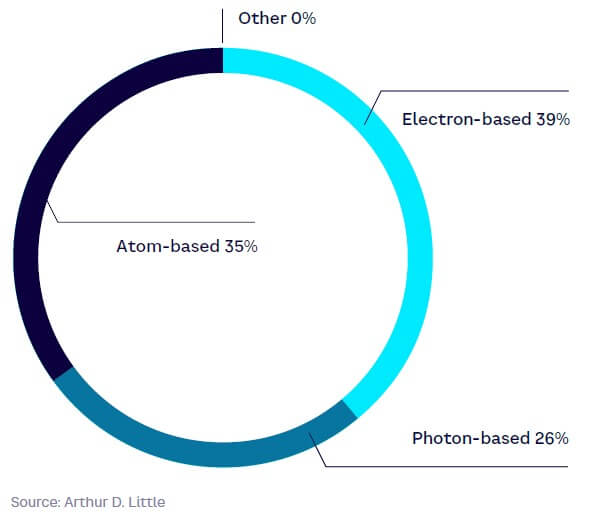
Most experts consider gate-based quantum computers to be the most promising, although simulators also have a significant following.
As well as alternative qubit technologies, developers are pursuing different computational paradigms, which can be split into three types. First, gate-based quantum computers use logic gates like classical computers and have the broadest general-purpose application. Second, annealers use low-quality qubits that are set to converge toward the solution, often the result of a search for minimal energy. The main applicability for annealers is for optimization and simulation problems, where today they offer the best-available quantum-based solution. Third, simulators refer to a broader category of analog device designed to model complex quantum mechanical systems. Up to now, they have been applied mainly to address complex physics challenges in the laboratory.
As shown in Figure 3, over 60% of the experts in our survey consider gate-based quantum computers to be the most promising, although a substantial minority of 32% considered simulators as the most promising. Thus it is still far from certain that the gate-based approach will be the only one that succeeds.

Most experts expect that QC technology will reach at least the stage of successfully demonstrated initial operation in 10 years’ time.
Today, QC technology development is generally assessed as being at the stage of lab-scale proof of concept; in other words, technology readiness level (TRL) 3 or 4,[1] although certain specific technologies, such as in the field of quantum communications and sensors, could be rated higher than this at perhaps TRL 6 or 7.
As shown in Figure 4, the majority of experts surveyed, around 65%, rate the most promising approaches to be at TRL 4 or less today. By 2025-2026, around 60% of our experts expect maturity to progress to at least full prototype demonstration for certain applications (TRL 6 or above), although 40% still expect TRL 5 or below. Some 75% expect to achieve successful initial operations (TRL 8 or 9) by 2032. However, it should be noted that even the top maturity levels of TRL 8 or 9 do not mean widespread commercial availability or significant market penetration.
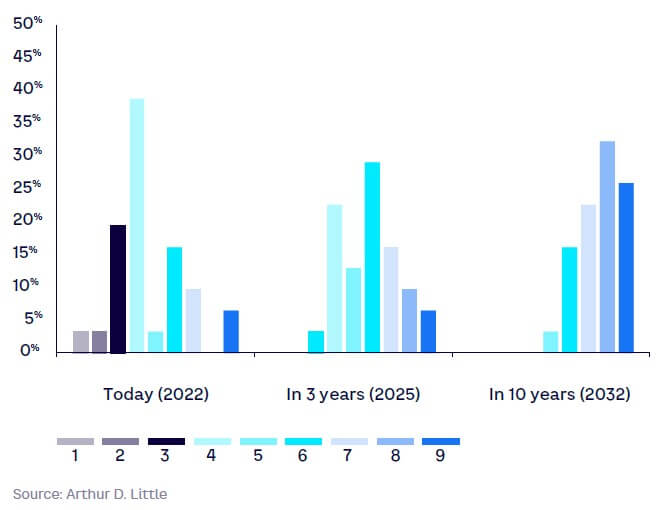
To gain a better forecasting perspective, pace and potential impact of technologies should be considered in addition to maturity.
As well as maturity (which of course is only a snapshot), to gain a better picture of the likely “time to impact,” it is helpful to also consider two other parameters:
-
Pace — the speed and slope at which a technology is developing, effectively the derivative of maturity. An indication of this can be provided by analyzing trends in levels of development activity. Most experts are predicting an increase from TRL 4 to TRL 8 in about 10 years for quantum computing — a pace of something like half a TRL per year on average. However, care must to taken in such assumptions since the pace curve is unlikely to be linear over the period.
-
Impact — the scale or level of disruption that the technology could cause if and when it matures. This can be assessed by considering potential use cases across different sectors. Some qubit technologies have features that make them more or less broadly applicable in terms of the types of problems they would solve.
In our main report, “Unleashing the business potential of quantum computing,” we provided an indication of these three parameters for qubit technologies (see Figure 5).
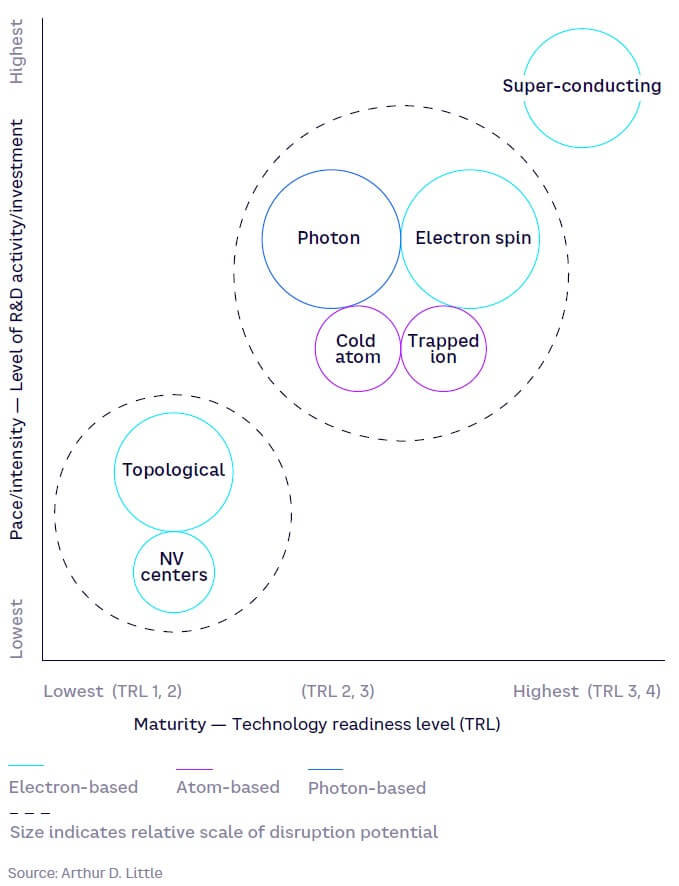
To help further inform the “pace” parameter, our partner Questel recently conducted a patent analysis of QC technologies. One of the outputs is shown in Figure 6.
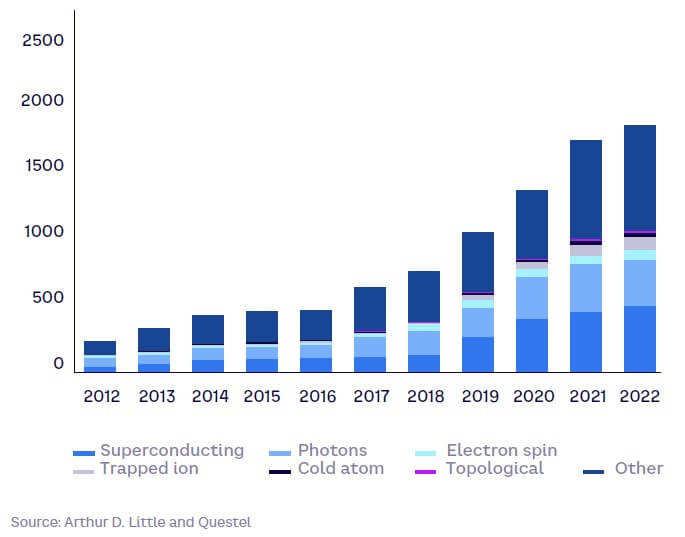
The steep rise in patents in the last five years to 2022 is a clear indication of the growth in the pace of development. The growth is very significant, at four times higher than the average growth of patents in general. The recent predominance of superconducting and, to a slightly lesser extent, photon-based technologies, is also clear.[2]
More generally, we are of the view that maturity, pace, and impact together can form the basis of a new “time to impact” index for business and are conducting further research we will publish at a later date.
WHAT ARE THE CRITICAL UNCERTAINTIES & SCENARIOS?
Although the basic uncertainty around if and when the remaining technological challenges will be overcome is clear, this is by no means the only determining factor for quantum computing’s future. To complete the picture we asked our experts to consider the level of impact and uncertainty of a range of other possible influencing factors on the ultimate availability and commercialization of QC technology. These included such factors as availability of investment and resources, geopolitical issues, demographics, climate change, regulation, and societal acceptance. The main results are shown in Figure 7.
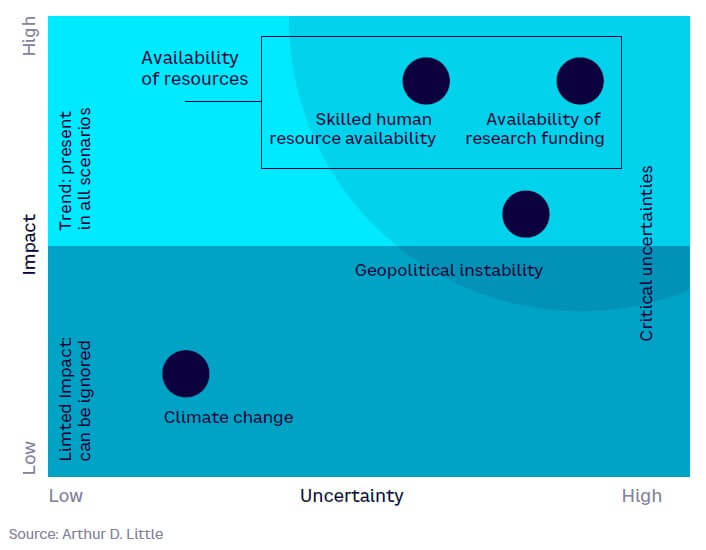
As illustrated in Figure 7, the experts rated “availability of research funding” as having the highest impact and uncertainty, followed by “skilled human resource availability” and “geopolitical instability.” We can consider these to be “critical uncertainties.” “Climate change” was also considered to have some impact, although more limited and less uncertain. The other factors were considered to be much less critical than these four or were subsets of them.
Availability of resources and geopolitical climate are the most critical factors shaping the future of QC development.
To help derive plausible scenarios, we took the three most critical factors, bracketing together “availability of research funding” and “human resource availability” into a single “availability of resources” factor, with “geopolitical climate” as the other critical factor.
Availability of resources for quantum computing refers specifically to the continued availability of adequate funding and skills for QC development and commercialization. It is likely to be affected by two key drivers, notably:
-
The global economic climate. A downturn or recession could drive a reduction in public and private R&D funding as governments and large companies are forced to reprioritize and downsize. Conversely, further economic growth and limited inflation would drive continued funding availability, although it could also further exacerbate the current human resource shortage of digital skills.
-
Key technology development milestone outcomes. The success or failure of promised QC development milestones/prototypes in the next few years could significantly change confidence levels, affecting investment readiness, ecosystem growth, and commitments to training and development of the necessary specialist skilled human resources.
The geopolitical climate refers to the extent to which QC development and commercialization proceed according to global free market forces, versus being restricted by national/regional geopolitical interests. Key drivers could include:
-
Regional and global conflicts. Continued and heightened regional conflicts (e.g., involving Russia, the US, Europe, China, the Middle East) could increase direct government control over national/regional QC development, restricting sharing of intellectual property and enforcing secrecy.
-
Rise of populism and protectionism. Continued prominence of populist and protectionist national leaderships could lead to damage to, or break up of, global QC ecosystems and international collaborations.
-
Key technology development milestone outcomes. As well as affecting confidence levels, rapid breakthroughs in QC development milestones, or the imminence of breaches in cryptographic security, could cause national governments to reassess current (fairly open) policies and enforce more restrictions and secrecy.
Based on the above, we have derived four plausible but extreme scenarios for how quantum computing could develop over the next decade (see Figure 8).

Quantum Summer: Rapid growth, major impact
In this scenario, the global economy has continued to grow over the decade despite short-term economic shocks from war, resource shortages, and the threat of inflation. Public and private funding for QC development has risen, driven by increasing optimism due to successful prototype performance and the demonstration of multiple realistic examples of quantum advantage. Education and training in specialist skills and capabilities have increased to meet demand. National governments have recognized their codependency for achieving rapid, commercializable quantum technology during the development phase at least, and have therefore continued to support open sharing of academic know-how and intelligence. Private enterprises largely have been given the freedom to pursue their own development roadmaps. Ecosystems are well-structured, comprising several leading global players as well as large numbers of medium-sized and smaller players. Increasingly, global industrial end users have increased their involvement in development and commercialization through investment and partnerships. Regulation has been developed to keep pace with developments, mainly to manage emerging safety and security risks. Despite some fears of the impact of quantum technology on societal and individual freedom and well-being, societal acceptance is generally good, helped by the visible benefits it has started to demonstrate.
Quantum Winter: Limited application, minor impact
In the Quantum Winter scenario, the global economy has been through an extended period of turbulence, including periods of recession and depression, as a result of continuing inflation, resource constraints, wars, protectionism, and a worsening climate crisis. Funding for quantum technology development has therefore reduced significantly, also due to disappointing early results in the achievement of key development milestones. National unrest, partly fueled by increasing living costs, has kept populist and protectionist governments in power. Increasing international aggression and suspicion have led to the breakup of global QC ecosystems and partnerships. Increased geopolitical risks have led governments to take a more interventionist line on development and commercialization, focusing on greater direct control, increased secrecy, and decreased public funding in areas other than defense and security. Regulation has been increased to enable greater protectionism and secrecy. Quantum computing is seen by society and media as seeming to be “always 10 years away” from commercialization.
Quantum Niches: Niche growth, some impact
In the Quantum Niches scenario, the global economy has struggled to find growth during a succession of crises, forcing Western governments to reprioritize and restrict public spending to meet fiscal constraints. Public funding in QC development has been reduced. Education and training in relevant specialist skills has been deprioritized accordingly, leading to a shortage of specialist capabilities. Development success in QC milestones has been limited to specific niche applications. Nevertheless, governments have recognized their codependency for the success of quantum technology during the development phase at least and have continued to support open sharing of academic know-how and intelligence in specific niche applications where real progress has been made. There is willingness to collaborate also in applications relating to energy and climate change. Quantum computing is perceived by society as being relevant only for a limited set of applications and is not seen as transformative for business and society as a whole.
Quantum Arms Race: Government-controlled, bound in secrecy
In the Quantum Arms Race scenario, liberal democracies have been diminished in influence at the expense of autocracies and dictatorships. Geopolitical blocks have strengthened their positions, and international collaboration has been reduced, breaking up global QC ecosystems and partnerships. At the same time, early breakthrough successes in development milestones have demonstrated its enormous potential. Nationalist governments have therefore taken an increasingly interventionist line on QC development, taking direct control over leading players in their countries and regions. Large countries such as the US and China have poured increasing funding into QC development under a heavy veil of secrecy, leading to a metaphorical and actual “arms race.” Applications in defense, security, and aerospace have been prioritized, although other non-military applications that provide strategic national advantage, such as energy and telecommunications, are also favored. Heavy regulation has forced players in QC development to align with national priorities. Society has little influence over the course of development, and media messages are tightly controlled.
CONCLUSION: HOW SHOULD BUSINESSES RESPOND?
Of course, the future may involve some combination of these four extremes, and there may be regional differences as well as shifts over time. It is clear as well that factors such as geopolitical stability and availability of resources will also have broader effects on new technology research and development in general, beyond quantum computing.
Nevertheless, it is helpful for businesses to be aware of their implications and avoid focusing exclusively on the technologies themselves. In our main Report, “Unleashing the business potential of quantum computing,” we identified four generic priorities for businesses to be adequately prepared:
1. Explore applicability
Explore where and how quantum computing could apply to your business, which means identifying intractable problems that cannot be solved by conventional computing and that could provide significant, disruptive advantage if they were solved. This requires creative thinking around what-if scenarios for how your business model or your industry could be disrupted if these new intractable problems were solved.
2. Monitor technical developments
Put in place a fit-for-purpose monitoring process of a scale appropriate for your business, including developing or acquiring the capability to understand the technology, setting up the channels to stay abreast of relevant developments, and rapidly evaluating their potential and limitations.
3. Engage in the ecosystem
Form partnering and collaborative relationships within the QC ecosystem and participate actively in pilots, co-funding initiatives, secondments, or temporary exchanges of staff and so on.
4. Build knowledge and capability
Invest in education and training of at least a small number of skilled individuals in quantum technologies, quantum programming, or even just a basic grounding to understand the language.
The emphasis that businesses should give to these priorities will vary depending on the scenario, as shown in Figure 9.
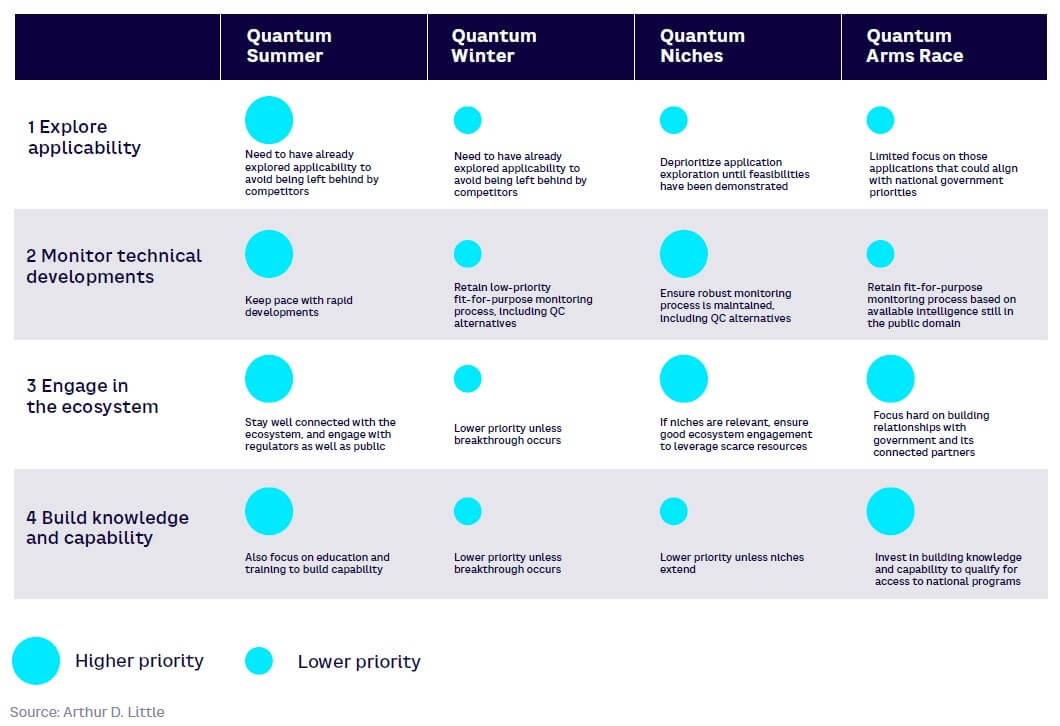
For businesses that are potential end users of QC technology, this is a difficult future to plan for. Given the exponential speed at which commercialization could take place, if there is a major breakthrough, many companies currently are rightly considering it prudent to assume that a Quantum Summer is likely and are preparing accordingly. For example, in a recent straw poll we conducted of 40 industrial end-user companies across multiple sectors, we found that:
-
Just under half of industrial end users (44%) have already started looking into quantum computing.
-
Of these companies, over 60% already started looking three or more years ago.
-
Around 45% had relevant internal expertise when they started.
So, many businesses are already aware and taking action. However, it is important that businesses are aware that the level of remaining uncertainty in QC development is still very high, and nothing can be taken for granted. It is vital, therefore, that businesses stay responsive and agile in the face of evolving events over the next decade. They need to look carefully not only at the progress of technology development itself, but also at how broader economic and geopolitical trends could radically change its future. Being able to demonstrate quantum advantage for a particular intractable problem is one thing — having a commercially viable, well-functioning, free market for the widespread deployment of quantum computing is quite another. Companies need to tread carefully.
Notes
[1] TRL is a widely adopted nine-point scale used to assess the maturity of technologies under development.
[2] It should be noted that the analysis excluded patent families relating to quantum cybersecurity, quantum telecommunications, and quantum sensors.


